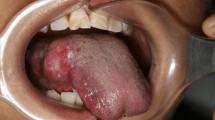Abstract
Objective
The purpose of this study was to evaluate the effect of postoperative radiotherapy (RT) on temporal volume changes with a cutaneous free flap (CF) and a myocutaneous free flap (MCF).
Methods
The subjects were 24 men and 11 women (mean age, 50.5 ± 15.5 years) with tongue or floor of mouth cancer. Twenty-seven cases of CF and eight cases of MCF were selected. The flap volume change of the reconstructed tongue was calculated using computed tomography (CT) images taken immediately and at one year postoperatively using the DICOM image processing software OsiriX®.
Results
The reduction rate in flap volume at one year postoperatively was 82.0 ± 15% in CF without RT, 70.3 ± 26.1% in CF with RT, 88.5 ± 14.7% in MCF without RT, and 99.5 ± 16% in MCF with RT. The MCF volume was significantly higher compared to the CF volume. Although postoperative RT reduced the CF volume by 30%, there was only a slight reduction in the MCF volume.
Conclusions
We evaluated the effect of postoperative RT on volume reduction in 35 cases of the reconstructed tongue with CF and MCF using a computer-assisted volume rendering technique. In this study, the effect of RT on volume reduction was different between the CF and MCF.



Similar content being viewed by others
References
Pignon JP, Bourhis J, et al. Chemotherapy added to locoregional treatment for head and neck squamous-cell carcinoma: three meta-analyses of updated individual data. Lancet. 2000;355:949–55.
National Comprehensive Cancer Network. NCCN Guidelines, Version 1. Panel Members Head and Neck Cancers, 2016.
Chim H, Salgado CJ, et al. Principles of head and neck reconstruction: an algorithm to guide flap selection. Semin Plast Surg. 2010;24:148–54.
Hsiao HT, Leu Y-S. Yi-Shing Leu : Primary closure versus radial forearm flap reconstruction after hemiglossectomy: functional assessment of swallowing and speech. Ann Plast Surg. 2020;49:612–6.
Joo Y-H, Hwang S-H, et al. Assessment of volume changes of radial forearm free flaps in head and neck cancer: long-term results. Oral Oncol. 2011;47:72–5.
Cho KJ, Joo YH, et al. Perioperative clinical factors affecting volume changes of reconstructed flaps in head and neck cancer patients: free versus regional flaps. Eur Arch Otorhinolaryngol. 2011;268:1061–5.
Sakamoto Y, Takahara T, et al. MRI analysis of chronological changes in free-flap volume in head and neck reconstruction by volumetry. Tokai J Exp Clin Med. 2014;39:44–50.
Kimura M, Takada K, et al. Quantitative analysis of chronological changes in the volume of flaps used for reconstruction of oral cavity defects. J Oral Sci. 2017;59:499–503.
Cai Y-C, Li C, et al. Comparative analysis of radial forearm free flap and anterolateral thigh flap in tongue reconstruction after radical resection of tongue cancer. ORL J Otorhinolaryngol Relat Spec. 2019;81:252–64.
Benanti E, Starnoni M, et al. Objective selection criteria between ALT and radial forearm flap in oral soft tissues reconstruction. Indian J Plast Surg. 2019;52:166–70.
Taiki Suzuki, Ichiro Tanaka, et al.: Preliminary Study of Temporal Change in Free Flap Volume after Tongue Reconstruction, Bull Tokyo Dent Coll. 2017;58:269–275.
Fujioka M, Masuda K, et al. Fatty tissue atrophy of free flap used for head and neck reconstruction. Microsurgery. 2010;31:32–5.
Yamaguchi K, Kimata Y, et al. Quantitative analysis of free flap volume changes in head and neck reconstruction. Head Neck. 2012;34:1403–7.
Sakamoto Y, Yanamoto S, et al. Magnitude of myocutaneous flaps and factors associated with loss of volume in oral cancer reconstructive surgery. J Oral Maxillofac Surg. 2016;74:644–9.
D’Onofrio M, De Robertis R, et al. Liver volumetry: is imaging reliable? Personal experience and review of the literature. World J Radiol. 2014;6:62–71.
Schmalbruch H, Al-Amood WS, et al. Morphology of long-term denervated rat soleus muscle and the effect of chronic electrical stimulation. J Physiol. 1991;441:233–41.
Oashi K, Furukawa H, et al. Vascularised fat flaps lose 44% of their weight 24 weeks after transplantation. J Plast Reconstr Aesth Surg. 2012;65:1403–9.
Pauchot J, Aubry S, et al. Preoperative imaging for deep inferior epigastric perforator flaps: a comparative study of computed tomographic angiography and magnetic resonance angiography. Eur J Plast Surf. 2012;35:795–801.
Ogino A, Onishi K, et al. Vascular waveform analysis of flap-feeding vessels using color doppler ultrasonography. Plast Surg Int. 2014;2014:1–8.
Urken ML, Weinberg H, et al. Microvascular free flaps in head and neck reconstruction. Arch Otolaryngol Head Neck Surg. 1994;120:633–40.
Tanaka K, Okazaki M, et al. Volumetric changes in transplanted vascularized fat flaps after ischemic or congestive stresses and their relationship to capillary density in a zucker fatty rat model. Microsurgery. 2015;35:653–6.
Peirong Y, Robb GL. Reconstruction for total and near-total glossectomy defects. Clin Plast Surg. 2005;32:411–9.
Hardee JP, Puppa MJ, et al. The effect of radiation dose on mouse skeletal muscle remodeling. Radiol Oncol. 2014;48:47–56.
Motoharu I. Ischemia-reperfusion changes in rat skeletal muscle morphology. Rigakuryoho Kagaku. 2012;27:91–6 (Japan).
Author information
Authors and Affiliations
Corresponding author
Ethics declarations
Conflict of interest
All authors declare that they have no conflict of interest. The others have no financial relationships to disclose.
Ethical approval
All procedures followed were in accordance with the ethical standards of the responsible committee on human experimentation (institutional and national) and with the Helsinki Declaration of 1975, as revised in 2008 (5) and was approved by the Ethics Review Board of Tokyo Dental College Ichikawa General Hospital (Approval Number: I16-35). Informed consent was obtained from all patients for inclusion in the study.
Human rights statement
All procedures followed were in accordance with the ethical standards of the responsible committee on human experimentation (institutional and national) and with the Helsinki Declaration of 1975, as revised in 2008.
Informed consent
Informed consent was waived due to the retrospective nature of this study.
Additional information
Publisher's Note
Springer Nature remains neutral with regard to jurisdictional claims in published maps and institutional affiliations.
Rights and permissions
About this article
Cite this article
Yamazaki, M., Suzuki, T., Hiraga, C. et al. Effect of postoperative radiotherapy for free flap volume changing after tongue reconstruction. Oral Radiol 37, 518–523 (2021). https://doi.org/10.1007/s11282-020-00489-0
Received:
Accepted:
Published:
Issue Date:
DOI: https://doi.org/10.1007/s11282-020-00489-0




